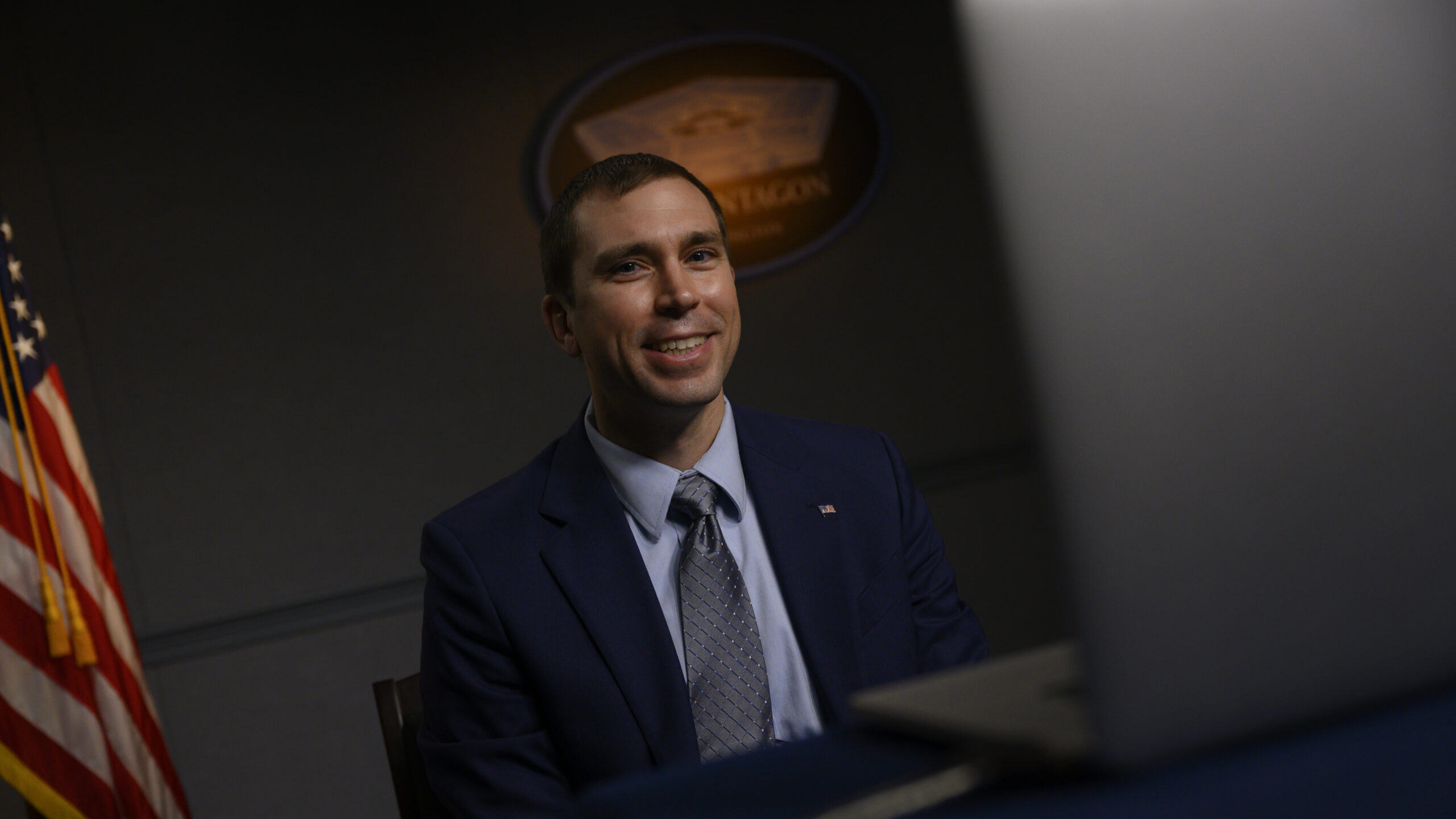
Space Development Agency Director Dr. Derek M. Tournear joins a discussion on “Changing Space Access through Emerging Technologies,” at a Defense One digital event, the Pentagon, Washington, D.C., Jan. 27, 2021. (DoD photo by Lisa Ferdinando)
AFA 2022 — Space Development Agency Director Derek Tournear wants to get one thing perfectly straight about the upcoming transfer of his agency into the Space Force: SDA will continue to function as an independent agency with no substantive changes to how it currently does its work.
In particular, he told reporters during the annual Air and Space Forces Association conference on Wednesday, SDA will remain separate from the service’s major acquisition arm, Space Systems Command.
“There’s confusion — internal and external,” to the Pentagon, Tournear said, about how SDA fits in.
“There’s confusion about where is SDA going to fall in the SSC org structure,” he added. “That’s easy: SDA is going to fall outside of the SSC org structure. So, we’re what is called a ‘direct reporting unit’. SSC is what’s called a ‘major command’. But basically we both report to [Assistant Secretary of the Air Force for Acquisition and Integration Frank] Calvelli for acquisition.”
SDA will transition from the oversight of Pentagon Undersecretary for Research and Engineering Heidi Shyu to that of the Space Force within the next couple of weeks, according to Pentagon officials. By law, it must be transferred by Oct. 1.
Within the Department of the Air Force, a direct reporting unit is an agency with a specialized mission that reports directly to a service chief of staff — in the case of SDA, Chief of Space Operations Gen. Jay Raymond. But because no military service has legal buying powers — that is a civilian leadership role — in its acquisition role SDA falls under Calvelli, who in turn reports to Air Force Secretary Frank Kendall.
Stressing that SDA has been provided both independent “non-acquisition” and acquisition authorities to allow it to set its own policies and choose how it develops and buys its own systems, Tournear said that he doesn’t expect any real changes in how the agency works, at least in the near-term.
The one difference will be that rather than the Office of Secretary of Defense providing acquisition approval for each two-year “tranche” of satellites under SDA’s planned National Defense Space Architecture, it will be the Space Force, he said.
Thus, the Space Force will have three acquisition organizations underneath Calvelli’s office: SSC, based in Los Angeles and headed by Maj. Gen. Michael Guetlein; Tournear’s SDA; and the Space Rapid Capabilities Office (Space RCO), newly led by Kelly Hammett.
RELATED: Rocket science: How Space Force acquisition works, with many players and dual hats
“There’ll be three independent arms that are all tools that Secretary Calvelli can use to provide capabilities to the warfighter,” Tournear said. While caveating that there will be mission overlaps that will need sorted out internally at Calvelli’s level, he explained that on the whole each organization has a different focus.
Eyes On ‘Proliferated’ Systems
For SDA, that focus for the moment is on “proliferated” systems — primarily satellite constellations stationed in low Earth orbit (LEO) “where we have all that expertise,” Tournear said.
Space RCO uses non-traditional acquisition tools to rapidly procure prototypes, he said, “especially on the classified side.” Space RCO also is a direct reporting unit.
SSC is charged with “making sure that the overall architecture fits together from a Space Force perspective,” Tournear said. “They are responsible for the bespoke, exquisite systems that have been delivered historically.”
However, he pointed out that as an example of why none of the organizations can be “pigeonholed,” SSC nonetheless was tapped to develop and build a multi-satellite missile warning/tracking constellation in Medium Earth Orbit (MEO) — as part of the overarching missile warning/tracking force design developed by the Space Warfighting Analysis Center (SWAC).
The way the system works, Tournear explained, is that once SWAC has come up with a force design for future capability, “they kinda throw it over the fence to the acquisition organizations.” Cavelli then “will be able to entertain proposals to provide that capability” from the three different shops and choose the procurement solution(s) best suited, he said.
Given Calvelli’s remarks to the AFA conference on Tuesday, it may actually be SSC that winds up seeing operational changes rather than SDA. He praised SDA’s spiral development model that allows satellites with new capabilities being launched every two years, and dissed expensive traditional space development programs — specifically targeting the multi-billion Next-Generation Overhead Persistent Infrared (Next-Gen OPIR) missile warning/tracking satellite program — that take as long as seven years to produce a design.
The decision by the Space Force to stop procurement of Next-Gen OPIR’s geosynchronous orbit (GEO) satellites after the first three — which Lockheed Martin is building under a $4.9 billion contract — in favor of a network of many LEO and MEO satellites is one portent of a strategic shift in space acquisition. The fact that SSC is using SDA’s spiral development model to acquire the planned MEO constellation is another.
“Spiral development has really, really taken hold,” Tournear said, adding that the “Space Force is behind us” in continuing with that approach as they build out their LEO constellations.
He noted, however, that the model will continue to need “a lot of advocacy within the department and external to make sure that industry can perform at these scales and these timeframes, which they’re showing they can, and then also that the department can respond in a requirements process and approval process on those timeframes.”






















